[课件]中考教材热点全解(冀教版七年级Book 1 Units 5~8)
- 格式:pps
- 大小:589.50 KB
- 文档页数:78
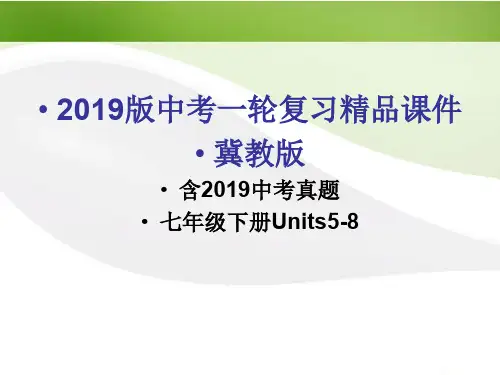
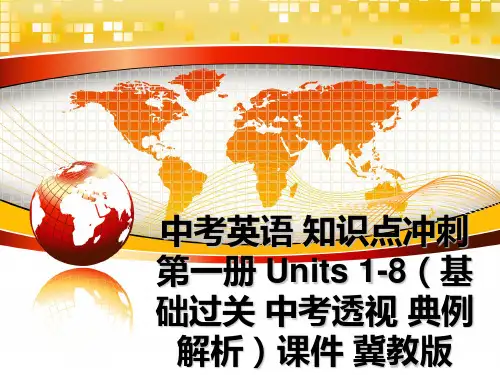
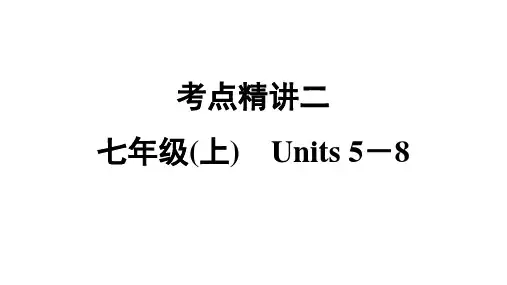
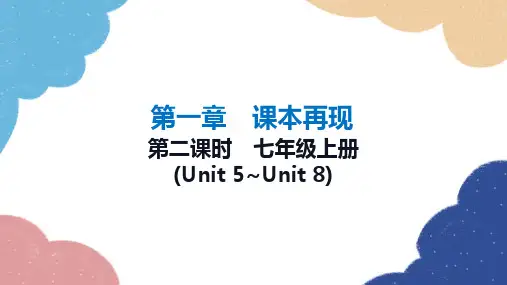

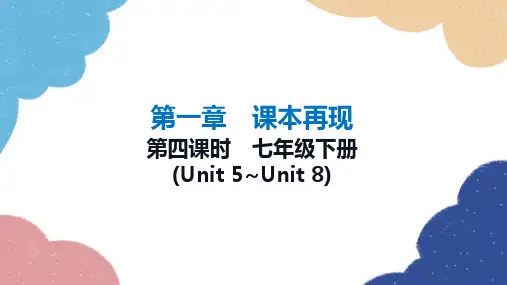
冀教版七年级Book 1 Units 5~8家庭父亲母亲兄弟观看躺需要出示1. family2. father3. mother4. brother5. watch6. lie7. need8. show 重点单词女儿通过……骑(车)贮藏贵的第九多云的著名的9. daughter 10. by 11. ride 12. store 13. expensive14. ninth15. cloudy16. famous 重点单词17. near 18. son 19. sister 20. bicycle 21. speak22. talk23. laugh24. above25. below 重点单词在……附近儿子姐妹自行车讲,说谈话笑在……上在……下点短语1. watch TV2. go to sleep3. go to school4. by bus5. turn left6. watch the movie7. New Year’s Day看电视去睡觉去上学乘公共汽车向左转观看电影新年点短语8. 儿童节9. 和……玩10. 国庆节11. 春节12. 远离13.天安门广场14. 故宫Children’s Dayplay with…National DaySpring Festivalfar fromTian’anmen SquarePalace Museum重点句型1. ---How old are you?---I’m …2. ---What is she/ he doing? ---She/ He is …你多大了?我……她/他正在干什么?她/他……重点句型3. How do you…?4. Where’s the school?5. Three plus four equals seven.6. How is the weather?你怎样…?学校在哪里?三加上四等于七。
天气怎么样?重点句型7. What’s the date?8. May I help you?9. How much is this?10. What day is it?几月几号了?我可以帮助你吗?这个多少钱?星期几了?重点句型11. What time is it?12. Where are they from?13. Let’s sing a song.几点了?他们来自哪里?让我们唱首歌吧。
交际用语1. Happy birthday.2. Excuse me.3. Happy New Year to you.4. It’s time for lunch.生日快乐。
打扰了。
祝你新年快乐。
到了吃午饭的时间了。
书面表达假如你是Jim,根据所给的家谱,介绍你的家庭。
要求:语言流畅,不少于5句话。
Bruce Green (Jim’s grandfather)Jack Green (Jim’s father)Mary Green (Jim’s aunt)Sam (Jim’s brother)Tom (Jim’s cousin)Jim友情提示:介绍家庭情况时,应按一定的顺序,首先要总括介绍,指明所在地,然后可按家谱的提示由长辈到小辈的顺序一一介绍,最后可用一句话总结。
书面表达This is my family.We live in Canada.My grandfather is Bruce Green.He has a son and a daughter—Jack Green and Mary Green.Jack Green is my father.He has two sons—Sam and me.My aunt Mary Green has one son—Tom.Tom is my cousin.I love my family.family 1. family 意为“家,家庭”,作主语时,若强调整体,谓语动词用单数;若强调家庭中的每一个成员,谓语动词则用复数形式。
My family is a big one.我家是个大家庭。
His family are going to travel to the USA. 他全家打算去美国旅行。
There are 3 people in my family.我家有3口人。
家,家庭with2.固定搭配:family name 姓What’s your family name? 你姓什么?family tree 家谱with3.表示伴随,意为“与……一道”“跟……一起”。
1) She is playing with some children.2) Would you like to go to the shop with us?4. 比较:with 与andwith虽然with 与and都有“和”的意思,但词性不同。
with是介词,后接名词、代词或动名词,接代词时,应该用宾格;and是连词,用来连接代词且作主语时,要用主格,作宾语时要用宾格。
1) Tom and I go to school every day.2) Please look after Kate and Lucy.3) Tom goes to school with me every day.5. 比较:with+东西与by+东西with“with+东西”表示行为主体(通常是人)把该东西当工具用;“by+东西”则表示该东西是行为的主体。
1) He was killed with a knife.=Someone killed him with a knife.2) She was killed by a falling tree.=A falling tree killed her.5. 比较:with+东西与by+东西with“with+东西”多半用use+东西代替。
“with+东西”能与how引导的疑问句相对应。
3) She cut the apple with a knife.=She used a knife to cut the apple.4) ---How did you write the letter?---I wrote it with a pencil.with6. with作伴随状语3. with 后可以跟介词短语、副词、形容词等作状语,修饰前面的动词,表示伴随情况。
1) They walked to the fields with baskets full of seeds on their shoulders.2) He is working there with the windows open.3) He came in, with a book in his hand.4) Don’t speak with your mouth full.with1) ---It’s necessary for us to take one hour’s exercise every day.---I agree _______ you.A. atB. toC. onD. with2) After class, I like playing computer games and chatting ______ my friends _______ the Internet.A. to; byB. with; onC. for; inD. about; through1. like作及物动词,意为“喜欢,喜爱”,后面可以接名词、代词宾格、动词不定式(to+v.)或动名词(v.-ing)作宾语。
1) I like this sweater.2) I like her very much.3) They like to go with us.4) He likes playing football.1. like还可作介词,意为“像……”,常与look或be 连用,也可以和其他动词或短语连用。
1) I look like my mother.2) This kite looks like a bird.3) He is like an English boy.4) I want a bag like this.1. 与情态动词would一起构成would like sth./ to do sth.结构,意思是“愿意/想要做某事”。
它相当于want,但它比want的语气更委婉,其后接名词或动词不定式。
1) I would like a cup of tea.2) The children would like to go to the zoo.2. How do you like…? “你觉得……怎么样?”通常用于询问对方对某物或某人的算法。
---How do you like China?---It’s great!3. I’d like/ love to… “我很愿意…… ”,用来回答对方的请求、建议或邀请。
---How about like playing tennis?---Yes, I’d like to.likeA. doB. isC. doesD. are1) ---What ______ your English teacher look like?---She is quite slim.1. from是介词,意为“从……,自……来,出自”,be from “来自……,出自…… ”。
1) ---Where are you from?---I’m from China.2) Here is a letter from my brother.2. from后还可接原料,意为“由”,尤其指原料与成品间已发生质变,从成品看不出原料的痕迹。
如果材料变成成品后没有发生质变,则须用of。
1) Paper is made from wood.2) A desk is made of wood.3. from还可以表示距离,意为“距……”。
The village is five miles from the factory.---Do you go to school every day?---No, we go to school only _____ Monday to Friday.A. fromB. onC. betweenD. in---Do you go to school every day? ---No, we go to school only _____ Monday to Friday.A. fromB. onC. betweenD. incotheswhose是表示所有关系的特殊疑问词,用来引导对物的主人进行提问的特殊疑问句,既可单独使用作表语,也可以作定语,修饰单数或者复数名词。